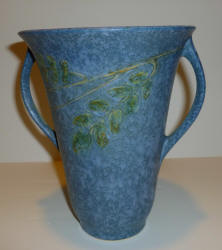A small sampling of what you can expect to see at the
exhibit. Click on the picture to get a high resolution version.
_small.jpg)
Roseville “Vase Assortment” pieces were Roseville’s earliest art
pottery, beginning around 1896. The vases were sold in bulk to the A&P
Grocery chain, where they were given away as premiums to customers.` |
_small.jpg)
Roseville Azurean vase, ca. 1902. This is blue version of Roseville’s
Rozane line, with hand painted decoration. |
_small.jpg)
Roseville Crocus planter, ca. 1904. |
_small.jpg)
Matt Green colored pottery was very popular with the oak Arts and Crafts
furniture of the early 20th Century, and Chloron was one of two
all-green lines introduced by Roseville in 1905. |
_small.jpg)
Roseville Egypto, 1905, in the form of an ancient Roman oil lamp. |
_small.jpg)
Della Robia vase. This line was created by Frederick H. Rhead who was
Roseville’s art director from 1904 through 1908. |
_small.jpg)
Gazo Foudji was a Japanese-born artist who worked at the Weller Pottery
before moving to Roseville (ca. 1905-1906) and creating the Fudji
(pictured) and Fujiyama lines. |
_small.jpg)
Roseville Crystalis, 1906, is highly sought after by collectors for
its crystalline glazes and creative forms. |
_small.jpg)
Roseville Early Utility pitchers. Introduced around 1900 and popular
for decades thereafter, Roseville made dozens of different pitchers. Some
Roseville collectors specialize in pitchers alone! |
_small.jpg)
Roseville Creamware “Good Night” candle holder. Roseville began
making decaled Creamware utility ware by 1910 and continued making it at
least through the 1920s if not longer.. |
_small.jpg)
Roseville Creamware window box, with an early automobile facing off
with a cow. “Tourist” creamware is probably Rosevilles most sought after and
valuable creamware lines. |
_small.jpg)
Roseville Early Velmoss vase, ca. 1916. This line was unidentified as
Roseville until collectors found a marked example and identified the shape
numbers in a 1916 price guide in the 1990s. |
_small.jpg)
Roseville Rosecraft, 1921, also known at Florane when it appears in
this tan color. The form of this vase foreshadows the art deco telescoping
and saucer-like shapes that were perfected in the Futura line seven
years later. |
_small.jpg)
Roseville’s Rosecraft Hexagon, 1925, was a simply shaped Art Deco
line made in either brown or green, and more rarely, a glossy blue. |
_small.jpg)
15. Roseville Carnelian II, 1926. This line followed a line called
Carnelian I and was produced in shades of red or green or a mix of red
and green. |
_small.jpg)
16. Roseville Futura, 1928. Futura is an Art Deco line that
was made in 78 different shapes and is one of the most popular lines among
today’s collectors. A green globe, modernistic shape. |

Windsor, introduced by Roseville in 1931. This fern-decorated pattern
was made in blue and rusty brown. |
_small.jpg)
The Wisteria line, first produced in 1933, is highly valued among
collectors today. |
%20and%20Modern%20(1953)_small.jpg)
A sleek blue Pine Cone "400 series" pitcher from 1953, and the
smaller, older model designed in the 1930s. |
_small.jpg)
Coffeepot from the Mock Orange line, first produced in 1950, typical
of Roseville’s late production style. |









_small.jpg)
_small.jpg)
_small.jpg)
_small.jpg)
_small.jpg)
_small.jpg)
_small.jpg)
_small.jpg)
_small.jpg)
_small.jpg)
_small.jpg)
_small.jpg)
_small.jpg)
_small.jpg)
_small.jpg)
_small.jpg)

_small.jpg)
%20and%20Modern%20(1953)_small.jpg)
_small.jpg)